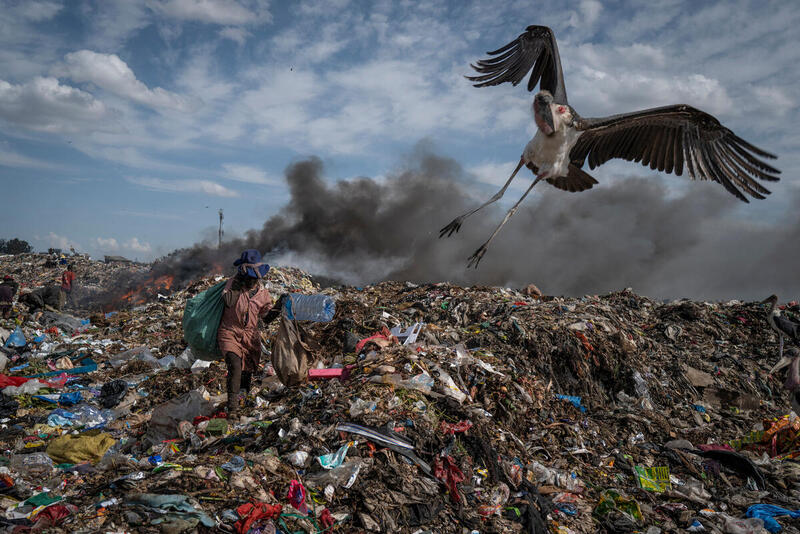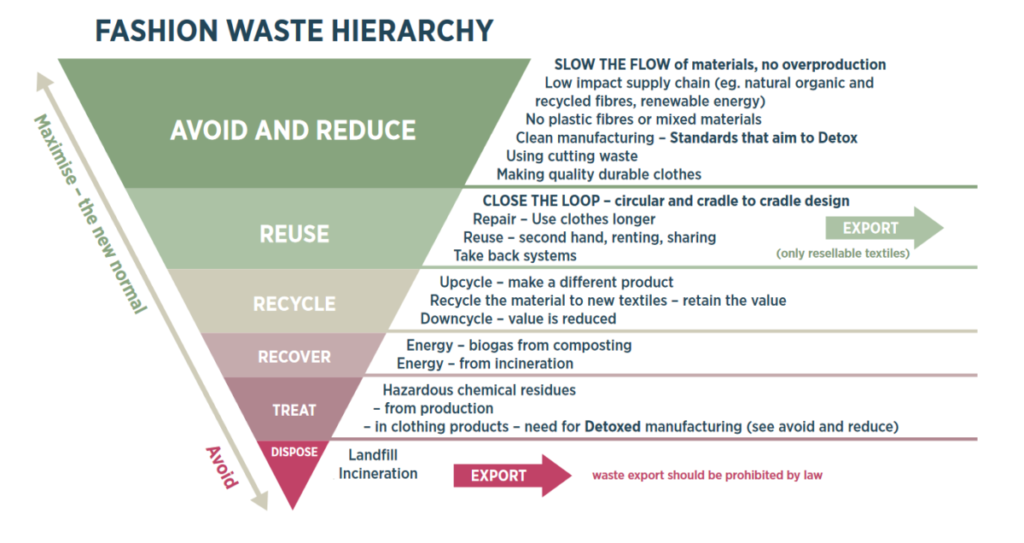Original article (in Croatian) was published on 11/04/2023
The rich countries of the West, under the guise of humanitarianism and aid, actually export their textile waste to the poorer countries of the world.
Excessive production, environmental pollution, and low possibility of recycling clothes – these are all problems of fast fashion, which is the second biggest polluter in the world.
Buying second-hand or donating (old) clothes is often suggested as a sustainable solution. And while big fashion houses and clothing manufacturers often talk about “circularity” and “sustainability”, donations and recycling of clothes, the problem of textile waste and excessive production and consumption of clothes remains.
Reports such as Trashion by the Changing Markets Foundation show that the rich countries of the West, under the guise of humanitarianism and aid, actually export their textile waste to the poorer countries of the world. Namely, used clothes mainly consist of plastic fibres that are very difficult to decompose, a small percentage of old clothes are recycled into new ones, and clothes that are exported – primarily to African countries – are often dirty, torn and, in a word, unusable, which is why their recycling and recovery becomes mission impossible.
In its report, the foundation investigated the problem of exporting used and donated clothing to African countries, primarily Kenya. Based on research and fieldwork by Trashion, it is estimated that in 2021 a total of 900 million pieces of clothing were exported to Kenya, and that one-third, about 300 million pieces, were made of synthetic fibres, and that as many as 458 million pieces of clothing were actually waste – damaged, dirty, torn. Thus, old and damaged pieces of clothing end up as waste in African rivers, landfills or are burned and further pollute the environment, which consequently leads to worsening waste pollution.

Greenpeace visiting a textile waste landfill in Kenya. Source: Kevin McElvaney/Greenpeace
Clothing donations or waste management?
For some rich countries, the export of plastic, clothing and plastic waste in general has become a way to alleviate or even solve the waste problem in their own countries. Some call the export of waste to poorer countries “toxic” or “waste colonialism”, and some critics believe that the source of garbage, textiles and similar waste to poorer countries is a way of easing the pressure in richer countries “addicted” to fast fashion.
On the other hand, the waste trade is a profitable industry, and used clothes can be sold for 400 to 1,000 euros per ton (Trashion). Data from the UN’s Comtrade database for 2019 and 2020 for exports from the European Union (EU) and the United Kingdom (UK) of used textiles (worn clothing and other worn items) show the largest exporters of used clothing worldwide: the UK and the EU in total exported 5,019,451 tons of waste clothing.
According to customs data from 2021, the following countries accounted for 95 percent of their second-hand clothing exports from the EU and the UK to Kenya: Germany (41.27%), Poland (24.68%), the UK (23, 05%), Hungary (3.28%), Italy (2.53%), Belgium (1.82%), Lithuania (1.42%), Estonia (0.67%), France (0.53% ) and Ireland (0.42%). The total value of exports in US dollars was 26,018,014 (24,838,617 euros). It is also estimated that the used clothing trade in Kenya employs up to two million people.
Since it is strong, durable and cheap, polyester is a frequent choice of fashion brands, making it the most used fibre in the world. However, due to its durability, polyester also presents a problem – it is not biodegradable. And while the EU is considering banning the export of plastic waste, and the export of plastic from Europe is limited by the Basel Convention on the Control of Cross-Border Transport of Hazardous Waste and its Disposal, similar measures do not exist for plastic fibres (Trashion), so plastic from clothing passes “under the radar”. Thus, dangerous plastic continues to be exported unhindered, only as part of clothing and textiles. Research by the International Union for Conservation of Nature and Natural Resources shows that most microplastics in the oceans (35%) come from synthetic textiles.
Clothes of increasingly poor quality
In the Trashion report, the calculation was made based on data on the total import of used clothing into Kenya, which for that country in 2021 amounted to 183,505,631 kilograms (UN Comtrade, 2021) and based on field research that showed that one bale of clothing contains an average of 40 kilograms or 200 pieces of clothing.
The above estimates are that some bales contain up to 50 percent of garbage, i.e. unusable pieces of clothing. The calculation for synthetic content was based on a survey of more than 4,000 items which showed that approximately 67 percent of clothing contained synthetic materials that were sometimes mixed with natural fibres or other synthetic materials.
Very often there is no sorting of the clothes before they are packed into bales, so these pieces are in all sorts of conditions and often unusable, and buyers in Kenya also notice that the clothes are of increasingly poor quality. Trade in used clothes is often described as a good way to reduce waste while at the same time helping countries of the so-called Global South because in these countries clothes are recycled or reused, while on the other hand, jobs are created.
However, according to the report, 17 pieces of clothing are sent globally per resident of Kenya. Of those 17 pieces per inhabitant, up to eight are too damaged, dirty or unsuitable for use. The supposed help is obviously becoming garbage.
How does it look in practice?
What do buying and selling look like in practice? The clothes are first donated to various charities that sell them in their stores. What fails to be sold to customers is then sold to exporters. They then (re)sell the clothes to customers in (mainly) African countries.
At markets, containers are opened and bales are taken out, which are then transported to warehouses where traders buy them “blindly”, without knowing exactly what they will get. The bales are then opened, and the clothes are sorted into high-quality, low-quality and what cannot be sold (Swahili: fagia). Fagia ends up as rags, kindling material or waste.

Source: Greenpeace
An alternative that is not
Donations and used clothes, i.e. the purchase and consumption of used clothes, are often presented as an alternative to the fast fashion system, better for the environment. Fashion theorist Lea Vene believes that the idea of textile waste “that travels as a kind of donation, so it can be sold on” is actually just a reflection of the functioning of the fashion system, namely that there is “a center that is enthroned in the West, and it seems to me that they ‘solve’ things by leaving or sending them to the periphery”. By buying used clothes, we do not solve a much wider problem, which is the problem of fast fashion, according to Vene. Fashion activist Tena Lavrencic agrees with her.
“The whole system of second-hand clothes is unsustainable. When you go to thrift stores, you see that the quality of those clothes is going down. Unfortunately, fast fashion is a dominant system, so at some point, it will also be found in SH stores. I’m starting to see Shein clothes regularly in those stores. I bet those clothes are mostly new, unworn”, says Lavrencic.
She still buys second-hand and vintage clothing, but she doesn’t consider them a solution. “All this is part of the system and is not an alternative system as we think. And that should be approached critically like the entire fashion industry”, she adds. “The problem is not how we buy, but how much we buy. And how much we produce”, she says.
At the same time, more clothes are consumed and bought. The Ellen MacArthur Foundation estimates that clothing purchases grew by 60 percent between 2000 and 2015. Thus, the amount of textile waste per capita increases.
It is necessary to change the attitude toward fashion
It is necessary to change the attitude toward fashion, points out Lavrencic, because “as long as we have the same logic that guides fast fashion, we have not changed anything. This is precisely why it is difficult to change something because such logic is at the core of the entire economy”.
She finds it interesting that we look at clothing items as having no value, that we believe that the price of clothing should be low and that clothing should not last long, and Faktograf has already written about this earlier. The idea of quality has also changed, says Lavrencic, so it seems to us that an item that has “lasted” for two years is of very high quality. Vene adds that the relationship with clothes and material is also lost. “The feeling that clothes need to be preserved or repaired is lost, and in fact, it would be good to inculcate the preservation of clothes as a new value”.
Lavrencic points out another phenomenon. Now even bigger chains and fashion houses are opening their stores or platforms for buying used goods or renting clothes. “Second-hand has become a business, a trend, especially for the younger generation. And brands will always follow trends”.
The growth of second-hand clothing stores expected
The manager of the Humana Nova Social Cooperative, Ivan Bozic, believes that the proliferation of second-hand clothing chains is “an expected response, given that new clothing and textiles are piling up, to put it mildly”. He sees the sale of second-hand clothes as one of the answers to fast fashion and preventing the immediate disposal of textiles as waste.
“It is necessary to ask the question of what will happen to these textiles when they become surplus even after being second-hand, but also about whether smarter production and smarter purchasing can affect the number of surpluses. Here we must mention the fact that in our case the textile disposal system has another social dimension, the entire process of textile waste management is related to work integration”, he says.
At the same time, textiles are difficult to recycle. As Faktograf has already written earlier, materials that are increasingly difficult to recycle are increasingly used in the production of clothing. Manufacturers focus on creating textiles that will find their place on the market, while the ecological component is often neglected. For example, for Humana Nova, which deals with the collection and recycling of clothing and textiles, the number of collected textiles grows every year, and on average, between 400 and 500 tons are collected annually. Of that, about 90 percent is “exclusively for recycling”, as they told us, because the quality of textiles is “diverse, but compared to other EU countries, it is extremely bad”.
There are also some advantages
Vene points out some economic advantages of used clothes, for example, the availability of clothes at an acceptable price for people of lower economic status, while she sees greater potential in systems that exist “at a lower level”, such as clothing exchange, in which clothes circulate “without a market element”.
It often happens that the fast fashion model is only reproduced, only in the context of used clothes, Vene points out. Thus, a large chain of second-hand clothing stores in Croatia “releases” new collections every now and then, even though they are second-hand clothes.
And while Humana Nova has a “rounded textile waste management system”, the question is how much this is the case for other clothing and textile manufacturers. We sent an inquiry to H&M since this chain has a system where they accept donations of clothing from customers and offer a discount for it. They also state on their website that they “turn old clothes into new”. We were interested to know how many donated clothes they receive and what happens to them, but we did not receive an answer.
The question is how “old clothes are turned into new”, when globally only one percent of old clothes are recycled into new ones. It would also be interesting to find out the percentage of polyester and how much cotton is in H&M’s creations, since on their website it is also stated that “100 percent” of their cotton is “recycled or comes from sustainable sources”.
Humana Nova, as we were told, through cooperation with numerous actors disposes part of the textiles or sends them for further recovery. Usable textiles are placed in their second-hand shop or donated “in cooperation with the Red Cross and the Center for Social Welfare”. Cotton is separated from unusable textiles, and Humana Nova then cuts it into industrial rags, which are sold mainly in the metal processing industry.
What remains after separating the cotton rags is taken to Regeneracija Zabok, where the textile goes into the recycling process to create felt, and the discarded textile “becomes a valuable raw material that is used for protection and insulation in construction”.
“What is an added value is the fact that the felt from Regeneracija Zabok comes to Humana Nova for cutting and packaging, which means that the cooperation created around the disposal of the textile waste directly affects 11 jobs in Humana Nova and that from a socially marginalized group of people. In this way, we have a complete process of disposal of textile waste, i.e. all textiles are used”, concludes Bozic.
And while Humana Nova may measure the profitability of its business model in terms of “social impact”, this is not the case with most actors in the fashion system. They are driven by profit, while some models that present themselves as solutions mostly just perpetuate the ethos of fast fashion.



